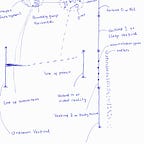Brain Science, Consciousness: How Do Psychedelics Alter the Human Mind?
Psychedelics have been in the news in recent days, with caution expressing stories like The dangerous hype around psychedelics as a treatment for mental illness, Psychedelics Open Your Brain. You Might Not Like What Falls In, Should You Buy Into the Hype of Microdosing Psychedelics?, and Why are people turning to psychedelics like ayahuasca?
Recently, the Therapeutic Goods Administration of Australia approved MDMA and psilocybin, for people with certain mental health conditions, as schedule 8 drugs — prescribe only by psychiatrists — from July, 1.
Psychedelic drugs include LSD (Lysergic acid diethylamide), Psilocybin, Mescaline, DMT (Diemethyltryptamine), Ibogaine (12-Methoxyibogamine), 2C-B (4-Bromo-2,5-dimethoxyphenethylamine), Peyote (Lophophora williamsii) and 25[-x]-NBOMe (N-methoxybenzyl).
There are several ongoing studies on hallucinogens and their therapeutic effects. There are retreats where people use them for different purposes. It is always recommended that they are used under supervision, to prevent bad trips. Psychedelics are said to over stimulate serotonin receptors in the brain, resulting in experiences where users feel more alert, have high sensitivity and perception, deeper consciousness, strong emotions, cognitive flexibility and so forth.
Brain science studies on hallucinogens are largely focused on the neurobiology of the brain, but if psychedelics are known to alter the mind, then the mind, for the experiences it gives should be the focus for its structure, functions and components that make psychedelics have their effects?
The human mind is the host of thoughts, memory, feelings, emotions, sense of self, free will, consciousness, meaning, and reactions. The human mind is within the brain, but its structure and function are different from the brain’s. Serotonin and other transmitters are the brain, mood, other states and experiences are the mind.
How does the human mind work to define how psychedelics shape it?
The Mind
To know how the mind works is to start from how senses come into the brain. All senses, as established by brain science, have relay centers for internal and external signals. It includes the brainstem, the thalamus, the substantia nigra and the olfactory bulb, for smell. It is at these hubs they are processed or integrated before relay to the cerebral cortex for interpretation.
This simply means that when senses — sight, smell, touch, taste, sound, internal, others — make their way into the brain, they land at ports where they are processed or integrated, from their differentiated states, before relay elsewhere for interpretation.
To find how the mind begins, it can be theorized that the processing of all senses or integration is into a uniform unit, quantity or identity, which is thought or in the form of thought. This means that any smell, taste, touch, sound or sight, becomes an emerged quantity, which is thought or in the form of thought. This is proposed to be how the brain generates the mind or how consciousness begins its interaction with objects. Simply, all senses become versions, equivalents or representations in the form of thought, to the mind.
It is what gets relayed to the cerebral cortex for interpretation. Interpretation is postulated to be knowing, feeling and reaction. Knowing is memory, dominating the rest.
More directly, senses become thoughts versions that relay to locations to be known, for feeling and then reacted to. These are the stages of mind — or see, convert to thought, know, feel and react. Thoughts or their form are quantities. Knowing, feeling, emotion, reactions are properties.
Quantities acquiring properties — to degrees — is how the human mind works, conceptually. Fear, depression, anxiety, shock, trauma, caution, hate, hurt, bias, interest, boredom, emptiness, loneliness, pain, thirst, hunger, sleep, violence, vindictiveness, comprehension and so forth are all properties on the mind. If acquired, they are experienced, if not, they aren’t.
Knowing something is a property, but if it further acquires the regret, guilt or sadness property, then it is experienced. There are situations that should be frightful where an individual is just cool or those that should not be, that the individual is, they are acquisitions — on the mind.
Quantities have their characteristics like early-splits or go-before, to anticipate or expect things, before others in the beam follow, exceeding what is explained as predictive coding or processing. Quantities also have old and new sequences of travel. They have prioritization and pre-prioritization phases. Just one quantity is prioritized on the mind at any moment, but there are fast and numerous interchanges with pre-prioritized. Acquisitions can be made in pre-prioritization, sometimes defining how bad moods come to be for just no reason.
Properties have group and single sets. Properties also have a principal spot where just one can go to have the most domination. Properties are planes, with different sizes, shapes and thickness. Quantities are relaying dots.
Psychedelics
All psychedelic experiences can be explained with the components of mind, quantities and properties, including their features. There are cases of psychedelic use where access to certain properties is increased, or degrees of acquisitions are altered from the usual, or where the thickness or shape of some changes. They may also drive quantities in converses of prioritization, splits or sequences. This could be evoking pleasant or unpleasant memories [or properties].
There are combinations that become possible by psychedelics, where they acquire properties, away from their regular areas, or creating new bounce points, for what should have been trauma to depression, or anxiety, instead to delight, lightness or others. There are also other cases where the property for craving of addiction from certain substances or the degree of reward they offer are reset, putting them elsewhere.
The sense of self, all states of consciousness offered by psychedelics are within the components of the mind in its conceptual structure. The human mind is the reason for the use of psychedelics, not for the brain, so the mind holds answers.
